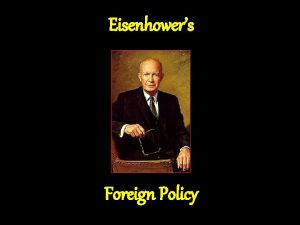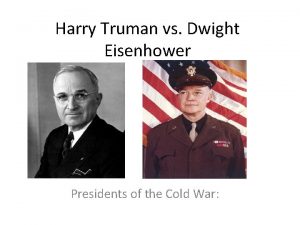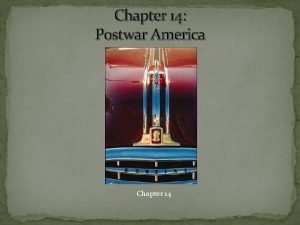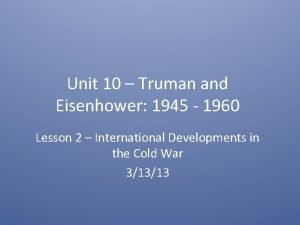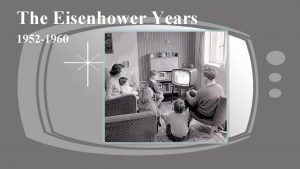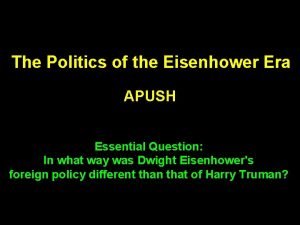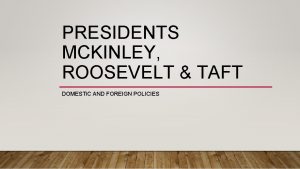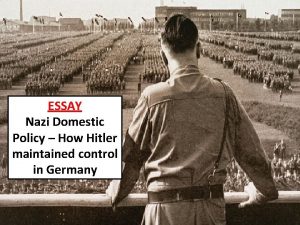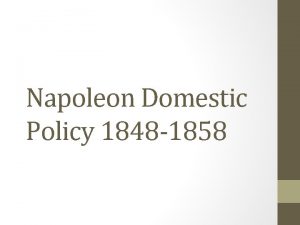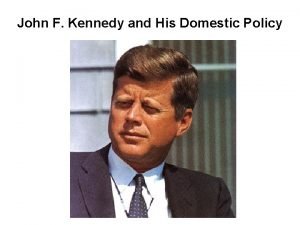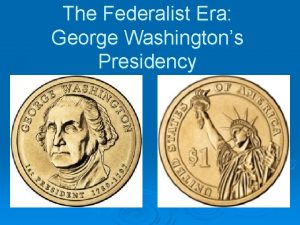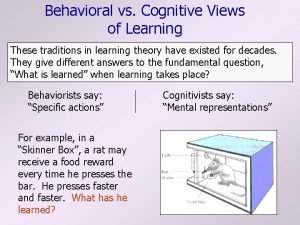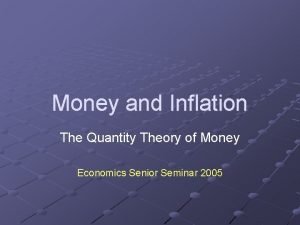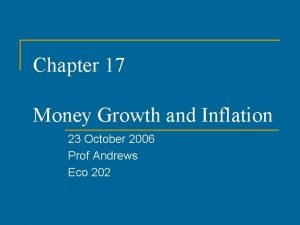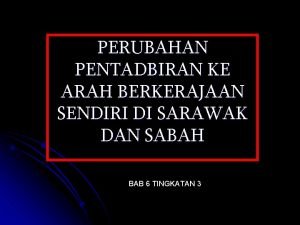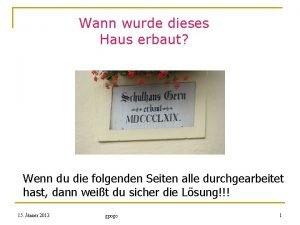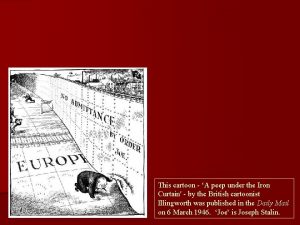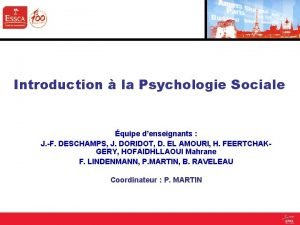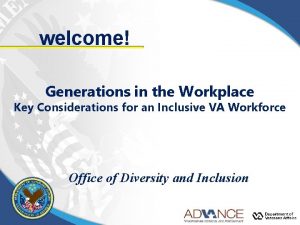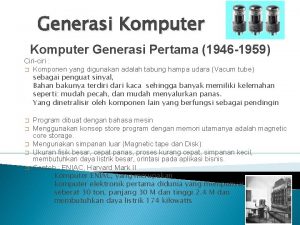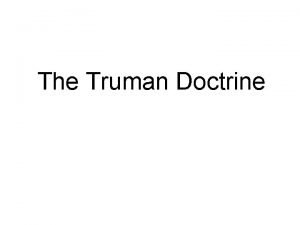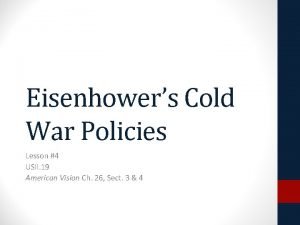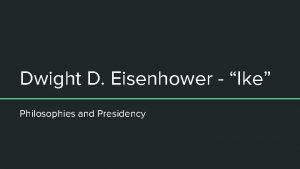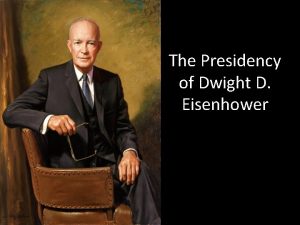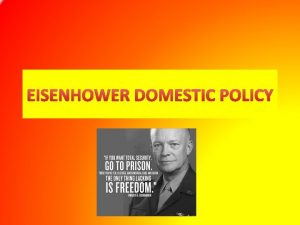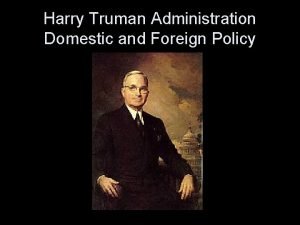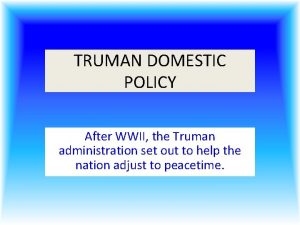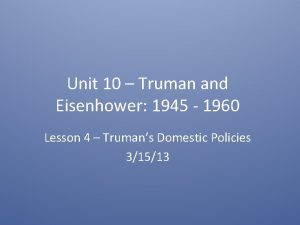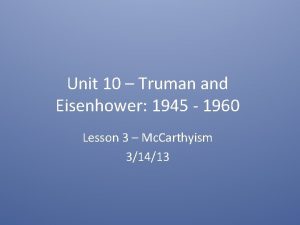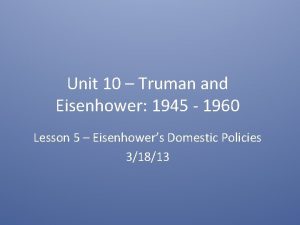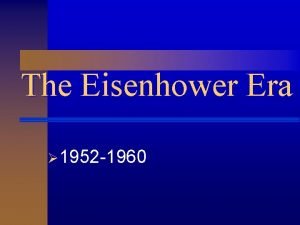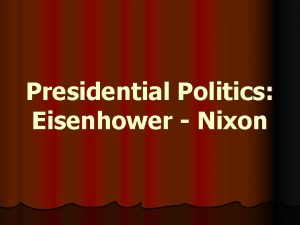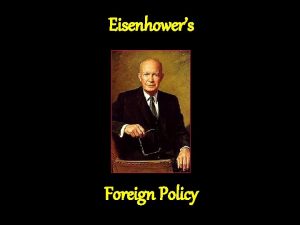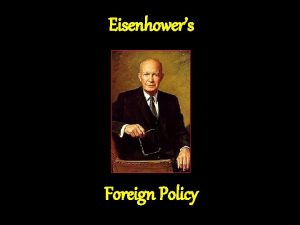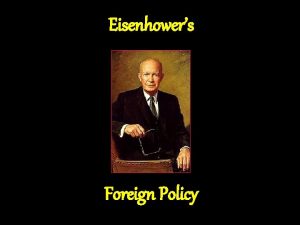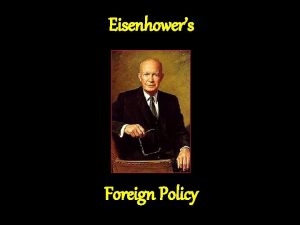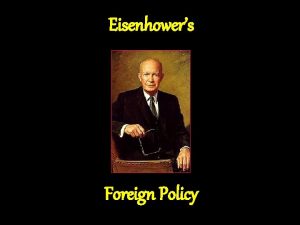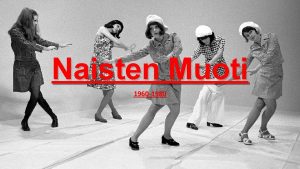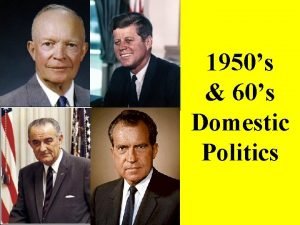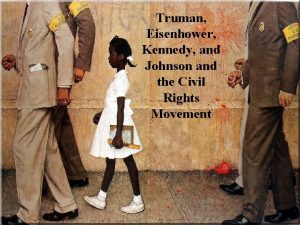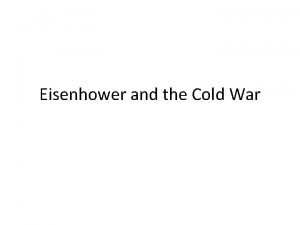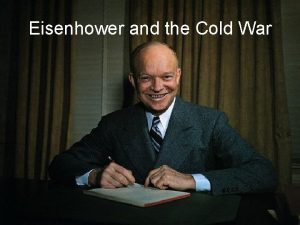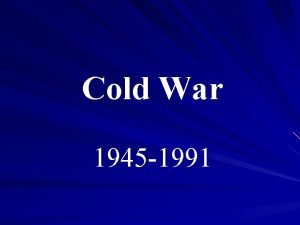Truman and Eisenhower Domestic Policy Politics 1946 1960













































- Slides: 45

Truman and Eisenhower Domestic Policy & Politics 1946 -1960

Peacetime Economy • Truman’s 1 st priority = reconversion ▫ Social and economic transition from wartime to consumer production • Americans wanted access to goods unavailable during the war • Government eased controls over economy in July 1946 = prices increased 25% ▫ INFLATION!!! • Wages did not keep pace with prices = labor unrest

Labor Unrest (1946) • Reasons: ▫ Inflation ▫ Workers demand wage increases • 1946 = 4. 6 million workers on strike ▫ Automobile, steel, electrical, coal, railroad ▫ Railroad Spring of 1946 Lasted 1 month Nationwide All Freight & Passenger Lines shutdown Truman threatened to draft the striking workers into the military

Taft-Hartley Act (1947) • Limited the Power of unions in the country after the war • Outlawed closed shop unions ▫ Shops that would only hire union workers • Continued to permit union shops ▫ Worker joined union after hired • Permit states to pass “right to work laws” ▫ Allowed states to prohibit union shops • President allowed to call for a “cooling-off” period before a strike ▫ Issue an injunction against work stoppage that endangered national safety or health • Bill was passed over a Truman veto

The Fair Deal • Continuation of the Liberal Practices of FDR’s New Deal • 21 Point program ▫ Expand Soc. Sec. benefits, raise min. wage, Fair Employment Practices Act, environment & public works projects, gov’t supported scientific research, nationalized atomic energy, national health insurance • 1946 Congressional elections = Republicans control both Houses ▫ Defeat Fair Deal

Truman on Civil Rights • Publicly supported civil rights • African-American leaders asked Truman to : ▫ Support anti-lynching laws ▫ Abolish poll tax as voting requirement ▫ Est. permanent board to prevent discriminatory hiring practices • Bans discrimination in hiring federal employees (July 1948) • Integrates the military

The Election of 1948 Candidates: Harry Truman (Democrat) Thomas Dewey (Republican, NY) -Ran in 1944, gained ground on FDR, expected to win the Presidency Strom Thurmond (Dixiecrat, SC) -Longest filibuster in US History, States’ Rights initiative, ran because of integration of military Henry Wallace (Progressives) -Friend of the Communist Party, believed that we needed socialized medicine, friendly relations with USSR, etc.

Background on 1948 • Early Polls ▫ Dewey 44%, Truman 31%, Thurmond 16%, Wallace 9% • Biggest Political Upset in US History • Whistlestop Campaign ▫ Attacks Republican Congress “Do-nothing” Farm policy ▫ “Give em hell, Harry!” • Dewey Defeats Truman? ? ? • Why? ▫ ▫ ▫ Truman went on the attack! Dewey never countered! African-Americans and other minorities voted for Truman ▫ Farmers remembered FDR during the Great Depression

Electoral Map of 1948

Revived Fair Deal • Raised minimum wage from $0. 40 to $0. 75 • Extend Social Security to 10 million more people & increased benefits by 75% • National Housing Act of 1949 ▫ Provide for construction of 810, 000 low-income housing units with long-term rent subsidies • Civil Rights ▫ Shelley v. Kraemer (1948) Courts could not be used to enforce private covenants meant to ban blacks from residential neighborhoods

Eisenhower & the Republicans in Election of 1952 • Campaign Platform of Republicans ▫ Korea, communism , corruption • Checkers Speech ▫ Sept. 1952 media accused VP Nixon nominee of having special fund set up by wealthy Republicans ▫ Responded to allegations Denied any wrongdoing Detailed his personal finances Only gift received was Checkers, “a little cocker spaniel”

Eisenhower’s Modern Republicanism • Determined to slow growth of federal government • Limit powers of the President & expand powers of Congress and courts • NOT interested in reversing the New Deal • “conservative when it comes to money, liberal when it comes to human beings” ▫ Ensure security of all Americans Extend Social Security to additional 10 million Raised minimum wage from $0. 75 to $1 • Cabinet composed of business men • Encouraged & supported corporate US

The Eisenhower Economy • Cuts in government spending = economic slump ▫ Tax revenues dropped ▫ Deficit grew larger • Economic growth declined ▫ 4. 3% (1947 -1952) ▫ 2. 5 % (1953 -1960) • Series of economic recessions ▫ 1953 -1954 ▫ 1957 -1958 ▫ 1960 -1961

Meeting the Technology Challenge • NASA (National Aeronautics & Space Administration) ▫ ▫ ▫ Formed after USSR launch of Sputnik in 1957 Independent agency for space exploration Explorer I Mercury Project Apollo Program • National Defense Education Act ▫ More federal money spent on science and math education Able to meet/beat the ability of Soviets ▫ Provided low-cost loans to college students if become teachers ▫ Gave money to state colleges/universities to build science and foreign language facilities

THE 1950 s: “Conservatism, Complacency, and Contentment” OR “Anxiety, Alienation, and Social Unrest” ? ?

Baby Boom It seems to me that every other young housewife I see is pregnant. -- British visitor to America, 1958 1957 1 baby born every 7 seconds

Baby Boom Dr. Benjamin Spock and the Anderson Quintuplets

Suburban Living Levittown, L. I. : “The American Dream” 1949 William Levitt produced 150 houses per week. $7, 990 or $60/month with no down payment.

Suburban Living: The New “American Dream” k 1 story high k 12’x 19’ living room k 2 bedrooms k tiled bathroom k garage k small backyard k front lawn By 1960 1/3 of the U. S. population in the suburbs.

Suburban Living SHIFTS IN POPULATION DISTRIBUTION, 1940 -1970 Central Cities Suburbs Rural Areas/ Small Towns 1940 31. 6% 1950 1960 1970 32. 3% 32. 6% 19. 5% 23. 8% 30. 7% 48. 9% 43. 9% 36. 7% U. S. Bureau of the Census. 32. 0% 41. 6% 26. 4%

Suburban Living: The Typical TV Suburban Families The Donna Reed Show 1958 -1966 Leave It to Beaver 1957 -1963 Father Knows Best 1954 -1958 The Ozzie & Harriet Show 1952 -1966

Consumerism 1950 Introduction of the Diner’s Card All babies were potential consumers who spearheaded a brand-new market for food, clothing, and shelter. -- Life Magazine (May, 1958)

Consumerism

A Changing Workplace Automation : 1947 -1957 factory workers decreased by 4. 3%, eliminating 1. 5 million blue-collar jobs. By 1956 more white-collar than blue-collar jobs in the U. S. Computers Mark I (1944). First IBM mainframe computer (1951). Corporate Consolidation : By 1960 600 corporations (1/2% of all U. S. companies) accounted for 53% of total corporate income. WHY? ? Cold War military buildup.

A Changing Workplace New Corporate Culture: “The Company Man” 1956 Sloan Wilson’s The Man in the Gray Flannel Suit

The Culture of the Car registrations: 1945 25, 000 1960 60, 000 2 -family cars doubles from 1951 -1958 Pink Cadillac 1959 Chevy Corvette 1956 Interstate Highway Act largest public works project in American history! Å Cost $32 billion. Å 41, 000 miles of new highways built.

The Culture of the Car America became a more homogeneous nation because of the automobile. First Mc. Donald’s (1955) Drive-In Movies Howard Johnson’s

The Culture of the Car The U. S. population was on the move in the 1950 s. NE & Mid-W S & SW(“Sunbelt” states) 1955 Disneyland opened in Southern California. (40% of the guests came from outside California, most by car. ) Frontier Land Main Street Tomorrow Land

Television 1946 1950 7, 000 TV sets in the U. S. 50, 000 TV sets in the U. S. Television is a vast wasteland. Newton Minnow, Chairman of the Federal Communications Commission, 1961 Mass Audience TV celebrated traditional American values. Truth, Justice, and the American way!

Television – The Western Davy Crockett King of the Wild Frontier Sheriff Matt Dillon, Gunsmoke The Lone Ranger (and his faithful sidekick, Tonto): Who is that masked man? ?

Television - Family Shows Glossy view of mostly middle-class suburban life. But. . . I Love Lucy Social Winners? . . . AND… The Honeymooners Loosers?

Teen Culture In the 1950 s the word “teenager” entered the American language. By 1956 13 mil. teens with $7 bil. to spend a year. 1951 “race music” “ROCK ‘N ROLL” Elvis Presley “The King”

Teen Culture “Juvenile Delinquency” ? ? ? 1951 J. D. Salinger’s A Catcher in the Rye Marlon Brando in The Wild One (1953) James Dean in Rebel Without a Cause (1955)

Teen Culture The “Beat” Generation: f Jack Kerouac On The Road f Allen Ginsberg poem, “Howl” f Neal Cassady f William S. Burroughs “Beatnik” “Clean” Teen

Teen Culture Behavioral Rules of the 1950 s: U Obey Authority. U Control Your Emotions. U Don’t Make Waves Fit in with the Group. U Don’t Even Think About Sex!!!

Religious Revival Today in the U. S. , the Christian faith is back in the center of things. --Time magazine, 1954 Church membership : 1940 64, 000 1960 114, 000 Television Preachers : 1. Catholic. Bishop Fulton J. Sheen “Life is Worth Living” 2. Methodist Minister Norman Vincent Peale The Power of Positive Thinking 3. Reverend Billy Graham ecumenical message; warned against the evils of Communism.

Religious Revival Hollywood : apex of the biblical epics. The Robe 1953 The Ten Commandments 1956 Ben Hur 1959 It’s un-American to be un-religious! The -- Christian Century, 1954

Well-Defined Gender Roles The ideal modern woman married, cooked and cared for her family, and kept herself busy by joining the local PTA and leading a troop of Campfire Girls. She entertained guests in her family’s suburban house and worked out on the trampoline to keep her size 12 figure. --Life magazine, 1956 Marilyn Monroe The ideal 1950 s man was the provider, protector, and the boss of the house. -- Life magazine, 1955 1956 William H. Whyte, Jr. The Organization Man A a middle-class, white suburban male is the ideal.

Well-Defined Gender Roles Changing Sexual Behavior: Alfred Kinsey: 1948 Sexual Behavior in the Human Male 1953 Sexual Behavior in the Human Female v v Premarital sex was common. Extramarital affairs were frequent among married couples. Kinsey’s results are an assault on the family as a basic unit of society, a negation of moral law, and a celebration of licentiousness. --Life magazine, early 1950 s

Progress Through Science 1951 --First IBM Mainframe Computer 1952 --Hydrogen Bomb Test 1953 --DNA Structure Discovered 1954 --Salk Vaccine Tested for Polio 1957 -- First Commercial. U. S. Nuclear Power Plant 1958 --NASA Created 1959 -- Press Conference of the. First 7 American Astronauts

Progress Through Science 1957 Russians launch SPUTNIK I 1958 National Defense Education Act

Progress Through Science UFO Sightings skyrocketed in the 1950 s. War of the Worlds Hollywood used aliens as a metaphor for whom ? ?

Progress Through Science Atomic Anxieties : à “Duck-and-Cover Generation” Atomic Testing : à 1946 -1962 U. S. exploded 217 nuclear weapons over the Pacific and in Nevada.

The 50 s Come to a Close 1959 Nixon-Khrushchev “Kitchen Debate” Cold War -----> Tensions <----Technology & Affluence

Class Discussion Topic: The postwar era witnessed tremendous economic growth and rising social contentment and conformity. Yet in the midst of such increasing affluence and comfortable domesticity, social critics expressed a growing sense of unease with American culture in the 1950 s. Assess the validity of the above statement and explain how the decade of the 1950 s laid the groundwork for the social and political turbulence of the 1960 s.
 Truman foreign policy vs eisenhower
Truman foreign policy vs eisenhower Eisenhower's domestic policy
Eisenhower's domestic policy Eisenhower and truman compare and contrast
Eisenhower and truman compare and contrast Lesson 1 truman and eisenhower
Lesson 1 truman and eisenhower Lesson 1 truman and eisenhower
Lesson 1 truman and eisenhower Korean war vietnam war venn diagram
Korean war vietnam war venn diagram The eisenhower years, 1952-1960
The eisenhower years, 1952-1960 Nato def apush
Nato def apush William h taft domestic policy
William h taft domestic policy Domestic policy of hitler
Domestic policy of hitler Domestic policies of napoleon
Domestic policies of napoleon What is domestic policy
What is domestic policy Thomas jefferson domestic policy
Thomas jefferson domestic policy Hatshepsut family
Hatshepsut family Domestic policies of kennedy
Domestic policies of kennedy Domestic policy
Domestic policy George washingtons domestic policy
George washingtons domestic policy Tolman ritchie and kalish (1946)
Tolman ritchie and kalish (1946) Hungary inflation rate 1946
Hungary inflation rate 1946 Fati timp
Fati timp Hungary inflation rate 1946
Hungary inflation rate 1946 Laporan barnes 1951
Laporan barnes 1951 Maksud berkerajaan sendiri
Maksud berkerajaan sendiri Lbb 1946/00
Lbb 1946/00 David alfaro siqueiros nueva resurrección
David alfaro siqueiros nueva resurrección Römische zahlen 1-15
Römische zahlen 1-15 Iron curtain political cartoons
Iron curtain political cartoons Dator 1946
Dator 1946 Carta da paz social 1946
Carta da paz social 1946 1980-1946
1980-1946 Ruang lingkup pkn di sd
Ruang lingkup pkn di sd Iso 1946
Iso 1946 Inférence définition
Inférence définition 1946 born
1946 born Laporan cheeseman
Laporan cheeseman Gambar komputer generasi pertama
Gambar komputer generasi pertama Marshall plan and truman doctrine
Marshall plan and truman doctrine Matriz de eisenhower excel
Matriz de eisenhower excel Lesson 4 eisenhower's cold war policies
Lesson 4 eisenhower's cold war policies Eisenhower philosophy
Eisenhower philosophy Eisenhower
Eisenhower Dwight d eisenhower accomplishments
Dwight d eisenhower accomplishments Eisenhower middle school everett
Eisenhower middle school everett Metoda eisenhower
Metoda eisenhower Eisenhower
Eisenhower Matrice di eisenhower excel download
Matrice di eisenhower excel download
